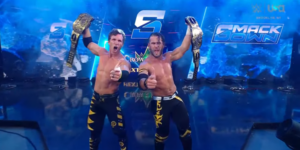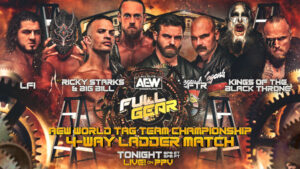Ever since January 4, 1992, New Japan Pro Wrestling (NJPW) has been holding an annual event at the Tokyo Dome. While it took a few years to find it’s footing, with various names until 1996’s Wrestling World, it wasn’t until the annual event was rebranded as Wrestle Kingdom in 2007 that NJPW had found its WrestleMania. But while 1992’s Super Warriors of Pro Wrestling may have been the first annual event to fall on January 4, it wasn’t the first time NJPW held a major event at the Tokyo Dome – affectionately referred to as “The Big Egg” by fans and locals. That occurred on April 24, 1989, with Battle Sattelite, marking 30 years since NJPW – and pro wrestling itself – first graced the floor of the Tokyo Dome.

The Tokyo Dome was first opened on March 17, 1988, nearly three years after ground was broken and construction began on May 16, 1985. The new state-of-the-art stadium was the new home for the Japanese baseball team Yomiuri Giants, who had previously played their home games at Tokyo Dome’s predecessor, Korakuen Stadium. Korakuen Stadium was demolished in 1988 to make way for the new larger Tokyo Dome (Korakuen held 42,337 in contrast to Tokyo Dome’s 45,600 for baseball games). The first major entertainment to enter the Tokyo Dome was Rolling Stones‘ frontman Mick Jagger in its second week open, followed by Bon Jovi, Michael Jackson, and others, while Mike Tyson defended his World title against Tony Tubbs in the Dome in the Dome’s opening year.

For decades, NJPW and other Japanese promotions, particularly their main rival, All Japan Wrestling, had been holding their bigger cards at places like Ryōgoku Kokugikan (Sumo Hall, capacity 11,098), Nippon Budokan (capacity 14,471), or the substantially smaller (yet still legendary) Korakuen Hall (capacity 2,005). While wrestling had long been a popular attraction in Japan, no promotion around had been bold enough to enter into baseball stadiums like Korakuen Stadium. But with the even larger Tokyo Dome now a spectacle in Tokyo, in 1989 it was New Japan who took the first plunge into the giant world of stadium pro wrestling. While it had been a staple in the United States for decades, going back as far as the legendary Frank Gotch vs George Hackenschmidt bout at Chicago’s Comiskey Park in 1911, that drew nearly 30,000 spectators, in Japan, pro wrestling was a more intimate affair, kept to smaller sumo or judo halls than arenas and stadiums. It wasn’t since the days of Rikidōzan‘s Japan Pro Wrestling Alliance (JWA) in the 1950s that a Japanese promotion had captured the Japanese audience to such a magnitude that it could sustain being a stadium that large – in 1957, 30,000 people attended Korakuen Stadium to see Rikidōzan face NWA World’s Heavyweight Lou Thesz.
But in 1989, New Japan was willing to take that gamble. While NJPW has enjoyed an alliance with the WWF for the better part of 20 years (with rival All Japan allying with the NWA), by 1989 Vince McMahon Jr. had severed his ties with NJPW, meaning that New Japan was on its own. And much like Vince had put his entire fate in the hands of the first WrestleMania at Madison Square Garden in New York City four years earlier, New Japan was determined to be the first pro wrestling promotion to hold a card in the brand new Tokyo Dome and bring Japanese puroresu back to the biggest stages in the country.

On April 24, 1989, NJPW held Battle Satellite, designed to showcase the best that NJPW had to offer, from its veterans to its Young Lions. On the tour leading up to the event, they held a Young Lions tournament, and the opening match was the finals of the tournament, that saw a young future IWGP Junior Heavyweight Champion Naoki Sano defeat another future legend in Hiro Saito to win the tournament.

The bulk of the card was designed around a tournament to crown a new IWGP Heavyweight Championship, that had been vacated on April 5, 1989, just prior to Battle Satellite. The tournament’s field was a who’s who of future legends, including 2x IWGP Heavyweight Champion Tatsumi Fujinami (who had held two of the three reigns since the belts inception in 1987), future 7x IWGP Heavyweight Champion Masahiro Chono, future 3x IWGP Heavyweight Champion Riki Choshu, future 3x IWGP Heavyweight Champion and NWA World’s Heavyweight Champion Shinya Hashimoto, and NWA star Buzz Sawyer amongst others. But it was New Japan’s new rising star Big Van Vader, an imposing behemoth in the ring, who defeated heavy favorite Fujinami in the final that night to become the new IWGP Heavyweight Champion.

The card also featured tag team action that saw George Takano & Super Strong Machine defeat Hiroshi Hase & Shiro Koshinaka, Salman Hashimikov defeat former WWF Superstar “Crusher” Bam Bam Bigelow, and Japanese legend Masa Saito. It also marked the New Japan debut of a new character, the masked marvel Jushin Thunder Liger. While he had been wrestling for NJPW since 1984 (under his real name of Keiichi Yamada), New Japan had made another gamble with debuting Yamada’s new character on its biggest show in history. Thirty years later, both the Tokyo Dome and Jushin Liger experiment have proven to be two of New Japan’s greatest success stories. The main event that night, in front of a whopping 53,600 fans, saw New Japan founder Antonio Inoki lose his NJPW Martial Arts Championship (a now-defunct title that carried over from his WWF Martial Arts title during the WWF-NJPW alliance) to Russian fighter Shota Chochishvili (the Shota experiment proved to be the only real failure of the entire event, as he left pro wrestling within the year).

Since then, the Tokyo Dome has become the pinnacle venue for all Japanese promotions and performers. The Grandest Sutēji of Them All. Three years after the success of Battle Satellite, New Japan would make Tokyo Dome the annual home of their January 4 event that in 2007 would become Wrestle Kingdom, and by 2019, would be the number one Japanese promotion in the world. There were many who didn’t expect New Japan to survive such an endeavor when Battle Satellite was announced, but 53,000 live fans later, it proved to be the company’s most successful gamble ever, solidifying New Japan as the big leagues and cementing its legacy that continues to this day.







